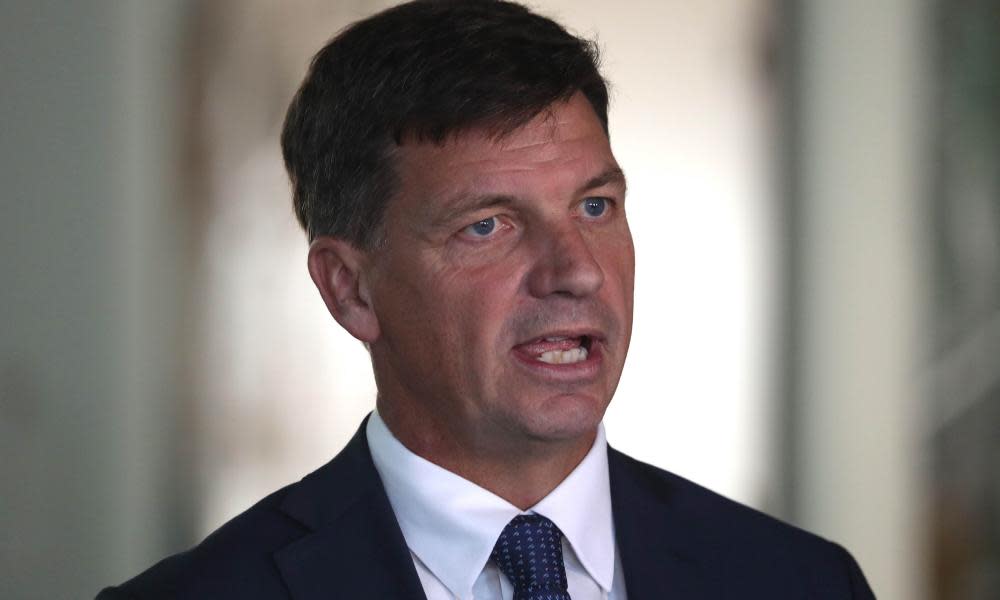Angus Taylor to announce shift in climate investment away from wind and solar

The Morrison government will on Friday signal plans to shift investment from wind and solar to hydrogen, carbon capture and storage, lithium and advanced livestock feed supplements, as part of a “bottom up” strategy to reduce emissions by 2050.
Angus Taylor will use a speech to an economic thinktank to put some flesh on the bones of the Coalition’s much-vaunted technology roadmap. The emissions reduction minister will also declare Australia will take a technology-based long-term emissions reduction “strategy” to the United Nations-led climate talks in Glasgow at the end of this year.
While not ruling out adopting a specific emissions reduction target, Taylor will contend the “top down” approach of countries proposing emissions reduction targets in the global climate framework has “failed” because countries are not delivering on their commitments.
Related: Australia’s electricity market must be 100% renewables by 2035 to achieve net zero by 2050 - study
According to a speech extract circulated in advance, Taylor will say the government intends to roll out “a series of detailed pieces of work” between now and the United Nations climate change conference in Glasgow, known at COP26, in November. Taylor will say Australia wants “to lead the world” on a new approach to laying out domestic abatement plans.
As well as the roadmap, the government is reviewing its much-criticised emissions reduction fund and the operation of the safeguard mechanism, and is working on an electric vehicles strategy, despite blasting Labor during last year’s election, claiming measures to drive the takeup of EVs were a “war on the weekend”.
Taylor will say the looming technology investment roadmap will form the cornerstone of the government’s 2050 emissions reduction strategy, providing guidance to the public and the private sector on “what future energy and emissions-reduction technologies the government will prioritise”.
He will say the government has already invested $10.4bn into clean technology projects with a value of $35bn, but declare “we are coming to an end of the value of these investments”.
“Wind and solar are economic as a source of pure energy at least, and the government should not crowd out private sector investment,” the minister will say. “We must move our investments to the next challenges – hydrogen, carbon capture and storage, lithium and advanced livestock feed supplements to name a few”.
Taylor will say the roadmap will include “measurable economic goals for technology that will allow us to assess the cost curve for technologies and to give a clear signal for when a technology is commercial”.
The government will be a player in investing in emerging technology “as both a market signal and leader” but the objective will be to generate significant private sector investment.
“To be successful from both a portfolio and from a technology perspective we must track how much private sector and other investment in R and D and early deployment follows our own investment,” Taylor will say.
“To measure the success of the overall portfolio I think we should be aiming for a four or five time multiplier. That is for every dollar invested I want to see four or five dollars from the private sector following over the course of our investments.”
It is unclear from the speech extract what policy mechanism will drive the new investments and who will administer the research and development, and it does not address why the government is looking at technology such as carbon capture and storage, or CCS.
Most low emissions scenarios for the future consider CCS a potentially important technology if the world is to keep global heating to 1.5C about pre-industrial levels, but only when used with biomass, not fossil fuels. The technology has not proved commercially viable with fossil fuel power generation despite being promised billions in taxpayer support through initiatives such as the CCS flagships program.
Most of the few CCS projects across the globe are demonstration plants in the industrial sector. Chevron last year announced a $2.5bn CCS project at one of the country’s largest liquefied natural gas developments, in the Pilbara, had finally begun injecting carbon dioxide underground after three years of delays.
Related: Killer heat: how a warming land is changing Australia forever
Taylor’s speech flags a consultation paper to inform the design of the roadmap.
The tone of the speech extract suggests the government is reluctant to adopt a target, having blasted Labor since the opposition adopted a net zero target by 2050 in its first major climate policy announcement since losing the 2019 election. But it is not definitive.
On Thursday, the Liberal MP Trent Zimmerman continued his call for the leadership to embrace net zero. “I think it is a target we need to look at,” the member for North Sydney told the ABC. “We have a good target for 2030 but we need to look beyond that as we head into Glasgow.”
Taylor will say on Friday: “If I could stand up today – announce a target and see the CO2 reduce – then I would.
“If setting a target today would lower emissions – then today would be a short speech. I wouldn’t have to outline our plan and I wouldn’t have to outline all the work that has led to today.”
Guardian Australia revealed on Thursday new analysis by ClimateWorks Australia suggesting Australia can achieve a transition to net zero emissions by 2050 with known technologies, but the deployment of low emissions options will need to be accelerated significantly.

 Yahoo News
Yahoo News 
